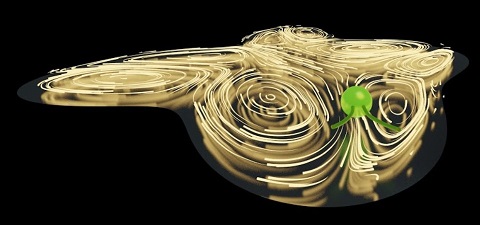Movements of microbes
Scientists have discovered how to predict the most likely movements of microorganisms such as motile algae like Chlamydomonas and bacteria like E. coli as they navigate their natural environments.

Researchers from Loughborough University, and Heinrich Heine University Düsseldorf, the Max Planck Institute for Dynamics and Self-Organization, and the University of Bayreuth, all in Germany, and the University of California, Merced, in the USA, have found a way to predict the most likely paths that these tiny single cells take as they move around in their microscopic habitats.
A new paper, published in the journal, Proc. Natl Acad. Sci. USA, reveals how the team observed and tracked the motions of a single Chlamydomonas cell, which was trapped in a sealed, water-filled chamber.
Using experiments and analytical and numerical calculations they studied the motion of the cell to determine how the microorganism would behave when exploring its surroundings.
The result was a set of computer simulated predictions which gave them flow maps of the most likely paths the cell would follow within the chamber.
These theoretical predictions were confirmed by experiments with living Chlamydomonas cells performed by the group of Oliver Bäumchen in Germany.
We discover a 'flow' of the most likely trajectory that follows the change in curvature of the confining boundaries and even influences regions within the bulk. “These findings might lead to devices that actively shape a microbe's average direction of movement, which could be of use to create confining channels with shape (and curvature) that can guide the motion of these cells.
Related links
- Loughborough University press release
- "Emergent probability fluxes in confined microbial navigation" - Featured in Proc. Natl. Acad. Sci (Proceedings of the National Academy of Sciences of the United States of America)*
Group information pages:
*Jan Cammann, Fabian Jan Schwarzendahl, Tanya Ostapenko, Danylo Lavrentovich, Oliver Bäumchen, Marco G. Mazza. Proceedings of the National Academy of Sciences Sep 2021, 118 (39) e2024752118; DOI: 10.1073/pnas.2024752118